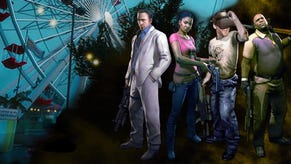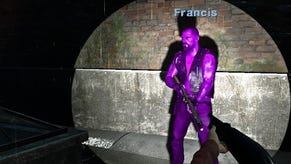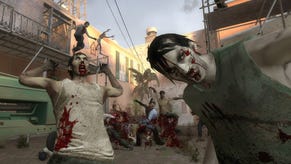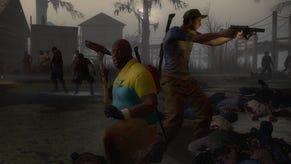Left 4 Dead 2: Specials, Weapons and Tactics
Out of the frying pan and into the face.
And this time, the specials are joined by what Valve terms, with typical smirking neatness, "uncommon commons": distinct members of the horde who are a little bit more powerful than most of their flailing one-shot allies. Ranging from riot police officers, who are capable of getting back up after their first knockdown, to the squeaky-shoed clown who alerts the rest of the infected to your location if you leave him alive long enough, and the powerfully unpleasant feral hillbillies of the swamp who skitter about, bent double, and will temporarily blind you with gunk if you let them, they provide a second level of unpredictability to the game, each of them with their own buff - one might be fire-proof, perhaps, or resistant to bullets from a certain angle - waiting to be uncovered and catalogued by the Valve faithful.
The common horde remains, of course, with new damage modelling meaning you can separate heads from necks, lop off arms, donut them through the chest, or even - most satisfyingly - take their legs out as they race towards you, and the inclusion of melee weapons makes them a much more tantalising prospect than before. This more intimate take on combat brings with it a smart risk/reward dynamic all of its own: to use a melee weapon, you're going to have to let the horde get in close where they can cause real damage.
That in turn requires you to fundamentally alter your tactics from the first game, which was often an arms-out stagger to keep space between you and the enemy. On the plus side, however, melees are so comically rewarding to use, it's impossible to do so without giggling: often thin on the ground, and replacing the pistols when equipped, the melee options on offer range from the already iconic frying pan, fast on its way to rivalling Freeman's crowbar as the thinking FPS player's blunt instrument of choice, to axes, night-sticks, katanas, an electric guitar, and a mean cricket bat.
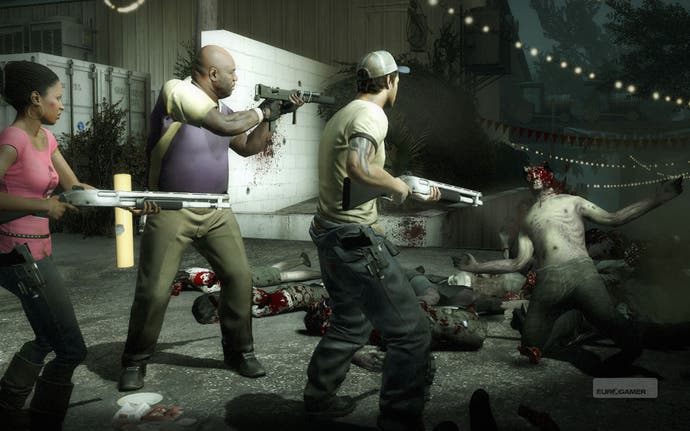
Sound effects, from the power-chord blast of the guitar to the Warner Brothers-styled hollow clang of the frying pan, double the satisfaction of doing someone a nasty injury, and, like the uncommon common you'll probably be battering with them, each melee has its own little secret quirk - axes, for example, are the only weapons which will allow you to fell a Witch from behind with one blow - another layer of secrets waiting to be uncovered and exploited. Add to that the changes made by the game's new day/night cycle, which sees the horde becoming more agitated whenever the sun's out, and an expanded traditional arsenal, swelled most brilliantly by the grenade launcher - deadly at a distance, absolutely disastrous up-close - and you start to get a picture of just how much even seasoned veterans are going to have to get ready to learn all over again on this outing.
There are other changes which are harder to gauge during a single afternoon's playthrough, of course, not least increased emphasis on story, which sees all the campaigns stitched together into one blood-soaked road trip across the South, and the fact that the AI director can now muddle specific parts of the level geometry around depending on how well you're playing, and call in weather effects like sudden summer storms that bring on the horde. But even if you're starting to tire of putting Francis and Zoey through their paces in the original game, Valve looks to be creating a sequel that balances continuity and complication in a very tempting manner.
In amongst the limb-lopping and the lucky headshots, the grand-slam calibre backchat, and the endless waiting around in closets (that's just me, generally), it isn't just the mechanics that are getting a refinement. Two games in, Left 4 Dead's visual identity is really starting to flourish: with its working class heroes, dungaree-clad infected, and endless bayous, Valve's sweaty thrill ride is emerging as a wonderful hick melodrama, detailed in everything from the high-school coaches and Fancy Dan conmen of its new character rosters to the white-trash detritus left behind in the wake of the apocalypse - the plastic lawn furniture sprawled around the streets of its cities, and the partially-destroyed clapboard motels and rusty pick-ups lolling in ditches.
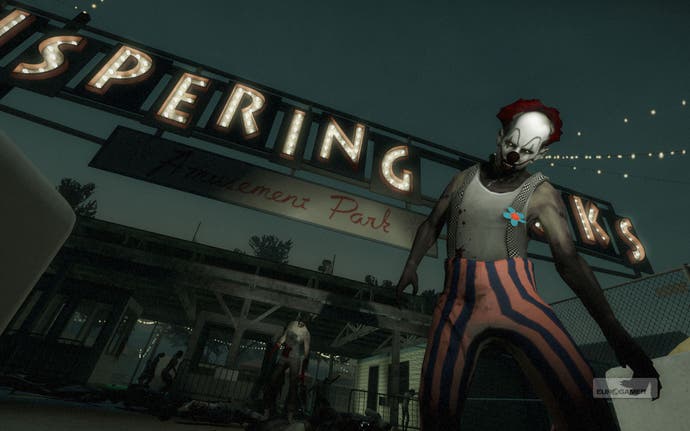
And there's a flexibility to it as well, its world capable of producing moments of eerie prettiness, as the evening light breaks through the grey mists of the swamp, picking out spectral stumps of trees and rotting spars of walkways, or throwing in bursts of over-hyped spectacle whenever the game ramps up for one of its final gauntlets, pitching you into a headlong race towards your escape vehicle, where bridges collapse and fighter jets flash past through the sky, filling the air with flame and smoke as the soundtrack rises to a ridiculous crescendo before lapsing back into creepy silence.
Crescendos and then silence: that was the heartbeat of the original Left 4 Dead, and it's the heartbeat for the sequel, too. With new tricks, new toys, and tweaks beneath the surface which Valve hopes you won't even notice, the murderous infected may have headed south for this outing, but there's no sign yet that they've started to go downhill.
Left 4 Dead 2 is due out for PC on 17th November via Steam, and at European retail for PC and Xbox 360 on 20th November.

